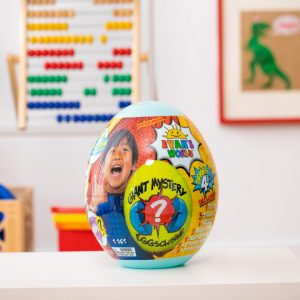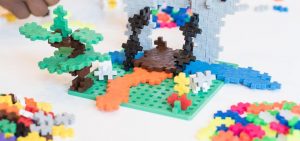
Article from Forbes, March 10, 2020
By Richard Kestenbaum
 A lot of ink has been spilled about why Toys R Us went bankrupt. But not much has been said about the unique place it filled in the market and who fills that spot now that Toys R Us has been reorganized into a much smaller entity. I spoke with Steve Pasierb, CEO of the Toy Industry Association, told me at last week’s Toy Fair that one of Toys R Us’ unique characteristics is that management would “take a chance on a small producer” before the biggest toy sellers, Amazon and Walmart, were generally willing to take a chance on small suppliers. Pasierb cites the example of Shopkins, miniature reproductions of branded consumer packaged goods, that came from a small Australian company. It was too risky for Walmart and Amazon, but Toys R Us carried it in all stores. The product exploded and eventually it was available everywhere and now it’s a toy industry staple. Pasierb says Toys R Us in its time was “the bridge to innovation” for the toy industry and the catalyst for many key trends.
A lot of ink has been spilled about why Toys R Us went bankrupt. But not much has been said about the unique place it filled in the market and who fills that spot now that Toys R Us has been reorganized into a much smaller entity. I spoke with Steve Pasierb, CEO of the Toy Industry Association, told me at last week’s Toy Fair that one of Toys R Us’ unique characteristics is that management would “take a chance on a small producer” before the biggest toy sellers, Amazon and Walmart, were generally willing to take a chance on small suppliers. Pasierb cites the example of Shopkins, miniature reproductions of branded consumer packaged goods, that came from a small Australian company. It was too risky for Walmart and Amazon, but Toys R Us carried it in all stores. The product exploded and eventually it was available everywhere and now it’s a toy industry staple. Pasierb says Toys R Us in its time was “the bridge to innovation” for the toy industry and the catalyst for many key trends.
There are now multiple sources for innovation in toys and one of them is media, particularly YouTube. Because children watch much more YouTube than traditional television, what’s popular there is a good indicator of what toys can be successful. What’s on YouTube doesn’t have to pass through a network programmer so it’s a true reflection of what gets kids’ attention. A company called Bonkers Toys is the paradigm of YouTube-driven product creation. Bonkers makes toys from what’s popular on YouTube. Their biggest products are licensed using the name Ryan’s World, the most popular children’s YouTube channel with over 35 billion views.
Using YouTube as a source of product development is consistent with what we are seeing in other consumer channels. Where consumer products used to be created by conceiving of a product and then creating content (what we used to call advertising), now there are blogs like Into The Gloss that spawned the creation of a related products business called Glossier and there are many other examples in other classes of products.
conceiving of a product and then creating content (what we used to call advertising), now there are blogs like Into The Gloss that spawned the creation of a related products business called Glossier and there are many other examples in other classes of products.
Other trends are coming from parents to retailers. In the past, that kind of communication was hard to develop but social media allows parents to make their needs known. They are pressuring retailers who in turn pressure brands to give parents what they want. Brands position many traditional products as part of trends that parents want now. What parents are asking for is:
Sustainability
At Toy Fair, probably no word was spoken more often than “sustainability.” Although sustainability means different things to different people, everyone in the industry is attacking the problem. It’s a harder challenge for toys than in most other businesses because so many products are made of plastic and aren’t suited or economical to be made otherwise. Getting plastic out of toy products is not likely, so companies are coming up with other ways to address sustainability. A scooter company called Micro Kickboard buys used fishing nets from commercial fisheries that would otherwise have left their old nets in the water where they could potentially have harmed wildlife. Micro Kickboard is making those old plastic nets into new scooters. It doesn’t solve the problem of plastic in the world, but it allows the company to show parents that is buildung new products without adding to the plastic waste problem.
 Less Screen Time
Less Screen Time
Parents have used screens for decades to entertain children and distract them. But there is a backlash against electronic entertainment among parents who are now emphasizing physical activity and intellectual engagement. A company called Plus-Plus makes plastic building blocks in the shape of plus signs (photo below). They market it as a way for kids to play and create without any electronic device. They also address sustainability by having their products made in Denmark where 50% of all power produced is from renewable sources. Another company showed me their dinosaurs and explained that since it has no batteries it’s part of the “kid-powered” trend.
STEM and STEAM
STEM stands for Science, Technology, Engineering and Mathematics. STEAM is STEM with Art. Whatever you call it, parents want more of it in their children’s activities. At Toy Fair, the ultimate STEM business was a company called Little Medical School. They sell toys but their main business is 33 locations where they conduct after-school programs teaching young children about medicine and science and encourage them to pursue further learning in the sciences. Because of what parents are asking for now, their business is booming and they are expanding into many more locations. A company called Oribel has built a system of levers and spinners that attach to the wall and children build paths for a small ball to travel down the system (pictured above). Oribel markets that new product as a “STEM Marble Run.”
Water
Water is wholesome, free and ubiquitous. Toys that transform themselves by coming into contact with water and revealing a hidden message, color or character are  popular. So are craft toys that use water to create designs and then wipe clean or dry and fade are also trending for no-mess, repeat play. Educational toys that teach children about underwater life match multiple trends and as always bath and outdoor water toys are popular.
popular. So are craft toys that use water to create designs and then wipe clean or dry and fade are also trending for no-mess, repeat play. Educational toys that teach children about underwater life match multiple trends and as always bath and outdoor water toys are popular.
Where This Goes
The world is getting along fine without the former Toys R Us. Several modes of innovation development have evolved to replace the important market function that Toys R Us served. But overall, toys are challenged. NPD reports that toy sales were down over 4% last year making them one of the three worst consumer product classes to be in. For a toy company to grow now, it has to take market share from a competitor and that’s the hardest kind of growth to have. My sources say the decline is partly from the demise of Toys R Us but also from parents whose attitude towards sustainability is to buy less that has to be thrown away. Toy companies are positioning their products to fit into what parents want now. That’s what they’ve always done but now toys are more a part of social value systems than ever before.
https://www.forbes.com/sites/richardkestenbaum/2020/03/10/the-latest-trends-in-the-toy-business-and-how-toy-trends-are-created/#742f81983c22
